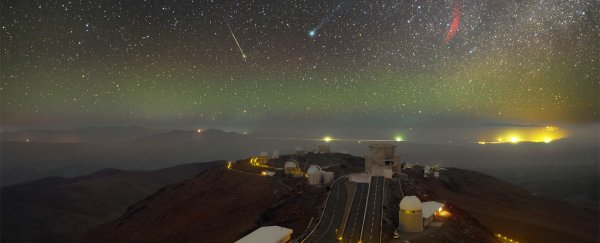This incredible long-exposure image was taken by the European Southern Observatory's (ESO) photo ambassador, Petr Horálek, throughout January 2015, and it's almost too good to be true.
Captured in the cloudless skies over the ESO's La Silla Observatory, which sits 2,400 metres above the Chilean Atacama Desert, the photo is a composite of images taken across different nights.
But the end result contains six incredibly phenomena.
Starting from the centre, we have…
- Comet Lovejoy, glowing green in the centre of the image.
- The star cluster known as the Pleiades, or the Seven Sisters, a little above Comet Lovejoy to the right.
- The California Nebula, the red arc of gas directly to the right of Lovejoy.
- A meteor, streaking along the left of the sky.
- A haze of glowing green light collecting along the horizon, as a result of oxygen in the upper atmosphere.
- A pretty shroud of low altitude clouds on the plain below the observatory.
- Oh and that streak of light on the plain? That's the Pan-American Highway.
As the ESO explains: "Comet Lovejoy's long tail is being pushed away from the comet by the solar wind. Carbon compounds that have been excited by ultraviolet radiation from the Sun give it its striking green hue."
This is the first time that the comet has passed through our part of the Solar System and lit up so spectacularly in around 11,000 years, and it won't be back for another 8,000 years.
The image was captured during a number of visits to the observatory in January with a very long exposure, although the bottom half uses only one of these exposures so that the landscape stays in focus.
Unfortunately, this combination isn't something we'd be able to see with our own eyes, but it sure is incredible to witness January's big sky phenomena laid out like this in front of us - we're glad someone was there to catch them all on camera. Let's hope 2015 can keep up the night sky activities.
You can download higher res versions of the image over at the ESO site.
